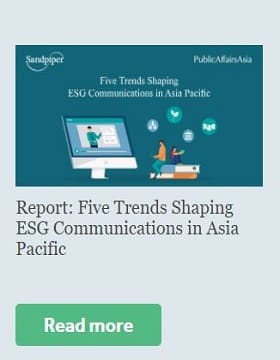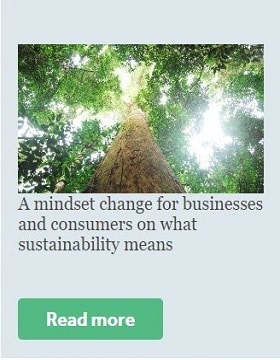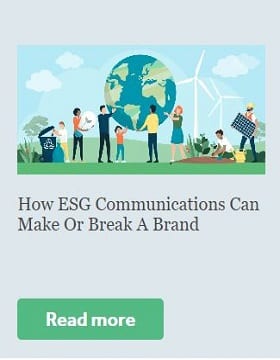
What employees want to hear – now

Winning Communications During and After COVID-19 – A Story That Evolves Daily
Earth Day 2020: What Climate Communicators Can Learn From COVID-19
22 April 2020
By Kelly Johnston

Climate Action was the theme of this year’s 50th anniversary of Earth Day.
The first Earth day in 1970, mobilised 10% of the U.S. population, with 20 million Americans protesting environmental ignorance. This new, little understood initiative is credited with launching the modern environmental movement. 50 years later the reach, awareness and understanding of climate change and its social, economic and environmental impact has increased exponentially as borne out in Sandpiper’s recent Consumer Expectations Index (CEI). The survey of 6,000 consumers across Australia, China, Hong Kong SAR, India, Malaysia and Singapore, found almost 96% of respondents are concerned about climate change, leaving a paltry 4% unconcerned about its impact.
That this year’s Earth Day coincided with another global crisis – the COVID-19 pandemic, has given rise to comparisons between the management, communication and responses surrounding both. While climate change can be a contentious topic, there is compelling and mounting scientific evidence that we are on a collision course with disaster if change does not occur fast.
According to the United Nations Environment Programme’s (UNEP) annual Emissions Report 2019, unless we can reduce global greenhouse gas emissions by 7.6 per cent annually between 2020 and 2030, we will fall short of the 1.5°C temperature goal of the Paris Agreement by 2030. If we fail to lower emissions, we can expect a rise in severe weather events, more health issues, increased pressure on natural resources such as food and water, and a decrease in global biodiversity.
Bridging Generation Gaps
With so much on the line, pre-COVID-19 there was increasing global debate and discontent around the actions (or lack thereof) of governments to combat climate change. However, a clear generational divide was also emerging – with the weight of action driven by Millennials and Generation X – with Greta Thunberg leading the “Fridays for Future” movement, which saw millions of school students striking globally.
With younger generations standing to be impacted the most in future decades, it is little surprise to see their unity behind climate action. On the flip side, they have also been, perhaps unfairly, singled- out in some forums for their perceived failure to take COVID-19 seriously – especially in the early stages of the crisis.
Is this fair? It is not for me to say but I believe it highlights the importance of finding common ground in potentially contentious or divisive communications that can bridge generational and stakeholder gaps.
Mixed Messages
One area where climate communicators can draw significant inspiration from the COVID-19 response is messaging. Both crises share similarities: escalating global disasters, the call for urgent collective action, the compromises required in our lifestyle choices, and the need to listen to and be led by science. Yet, COVID-19 has managed to inspire and mobilise global action in a time frame that is far beyond what the climate movement might have previously dreamed of.
If we look at why this has occurred and the era of digital communication that we are living in, a lot can be explained by the messaging.
It can be argued that both climate change and COVID-19 are equally complex issues – hallmarked by many unknowns and grey areas. However, for COVID-19, governments have largely managed to communicate very simple, consistent, highly targeted, and action driven mass communications to a broad spectrum of divergent audiences. For instance, we clearly understand that social distancing and wearing face masks will help each of us to play a role in combatting COVID-19. Yet, how many of us can say that we have a clear plan of attack to mitigate climate change? For most of us, we know the kinds of things we could do in everyday life to reduce carbon emissions but may not bother to do them because we are simply not sure if the effort will be worth it.
Secondly, the COVID-19 crisis evolves second-by-second around the world, lending itself to our fast paced, digital-first communications environment. Numerous trackers and case/death tally boards have sprung up as a result, leaving an impression that we can never be too up to date on the issue. For governments, they have needed to evolve their messaging at lightning speed to keep pace and maintain some semblance of control. While the cause and effect are much more direct for COVID- 19, it shows the power of building real-time, burning platforms around a crisis to inspire response – which can be translated to some degree for any social issue or campaign.
Another by-product of our digital world is that the “visual” messaging is more important than ever. COVID-19 has a very human face – we are bombarded with terrifying images of wards of patients in intensive care units, and impassioned calls from tired doctors and nurses imploring people to stay home. However, for climate change it could be argued that the imagery is less evocative. With COVID-19 there is the fear that this could be us; that we could be in that ICU bed, but for the majority of people, polar bears, melting ice caps and dry riverbeds are too far removed from everyday reality to form a compelling connection and evoke a similar emotional response.
Finally, in order to inspire action, there must always be hope. The most effective governments and organisations communicating during COVID-19 have been those who have offered hope in the face of the crisis. In anchoring too many communications in scare-tactics the climate movement risks leaving individual consumers feeling helpless to act in the face of such a daunting threat.
Unity More Important than Ever
Above all else, what COVID-19 has shown us is that it is possible to galvanise people globally towards a common goal, and that as societal integration increases, governments, organisations, communities and individuals must work more closely together.
COVID-19 and climate change will not be the only global crises in the coming decades and businesses must seek out ways now to form stronger government and community partnerships that enable them to play a positive role in solving these issues and ensure the sustainability of their industries. Whatever sustainability critique that industries faced pre-COVID-19, they should expect this will markedly increase in the coming 12 months.
Building unity means also making more room for our scientists to have a voice. Our CEI study shows that while scientists are among the most trusted voices in society by consumers, outranked only by an individual’s family members, their perceived ability to influence change falls below that of government and business leaders.
While COVID-19 has and will continue to have a devasting impact on our personal lives, families, society and economy for a long time to come, it is heartening to at least know there are useful learnings to be drawn in the way we approach future global challenges, and in how we shape effective communications programmes around these. At Sandpiper, we will continue to look closelyat how the issues develop to ensure we can provide the best advice for our clients to build meaningful purpose-led communications strategies and help future-proof their organisations. For more information on Sandpiper’s recent Consumer Expectations Index (CEI) please email: hello@Sandpipercomms.com.
You may also like:





